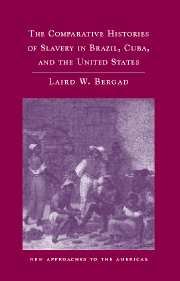Book contents
- Frontmatter
- Contents
- List of Maps and Figures
- Introduction
- 1 From Colonization to Abolition: Patterns of Historical Development in Brazil, Cuba, and the United States
- 2 The Diversity of Slavery in the Americas to 1790
- 3 Slaves in Their Own Words
- 4 Slave Populations
- 5 Economic Aspects
- 6 Making Space
- 7 Resistance and Rebellions
- 8 Abolition
- Bibliography
- Index
- Plate section
2 - The Diversity of Slavery in the Americas to 1790
Published online by Cambridge University Press: 05 June 2012
- Frontmatter
- Contents
- List of Maps and Figures
- Introduction
- 1 From Colonization to Abolition: Patterns of Historical Development in Brazil, Cuba, and the United States
- 2 The Diversity of Slavery in the Americas to 1790
- 3 Slaves in Their Own Words
- 4 Slave Populations
- 5 Economic Aspects
- 6 Making Space
- 7 Resistance and Rebellions
- 8 Abolition
- Bibliography
- Index
- Plate section
Summary
The word “slavery” inevitably conjures up a series of images: the cotton-picking slave of the U.S. South; the sugar cane–cutting slave gangs of the Caribbean and Brazil; and perhaps the domestic servants or house slaves present in all slave societies. These may be accurate for particular places during specific periods, but they are only partially indicative of the slave experience in the Americas. This is because of the extraordinary diversity of what it meant to be a slave in different epochs and regions. The patterns of daily life for a slave laboring on the Texas cotton frontier in the 1840s were dramatically different from those of a slave working in the eighteenth-century Chesapeake region, or a slave living in urban Richmond, Virginia. Aside from the horrifying and degrading reality of being treated and regarded as property – a powerful communality, no doubt – it is important to recognize that slavery was a complex institution with enormous variations as it developed and evolved regionally in the Americas from the early sixteenth century until slavery was finally abolished in Brazil in 1888. Despite popular perceptions and imagery, there are few generalizations about the slave experience that may be universally applied. Before turning to the comparative histories of slavery in the United States, Brazil, and Cuba, a summary of slavery's development in the Americas is needed so that slavery in these nations may be understood in its proper historical context.
- Type
- Chapter
- Information
- Publisher: Cambridge University PressPrint publication year: 2007



